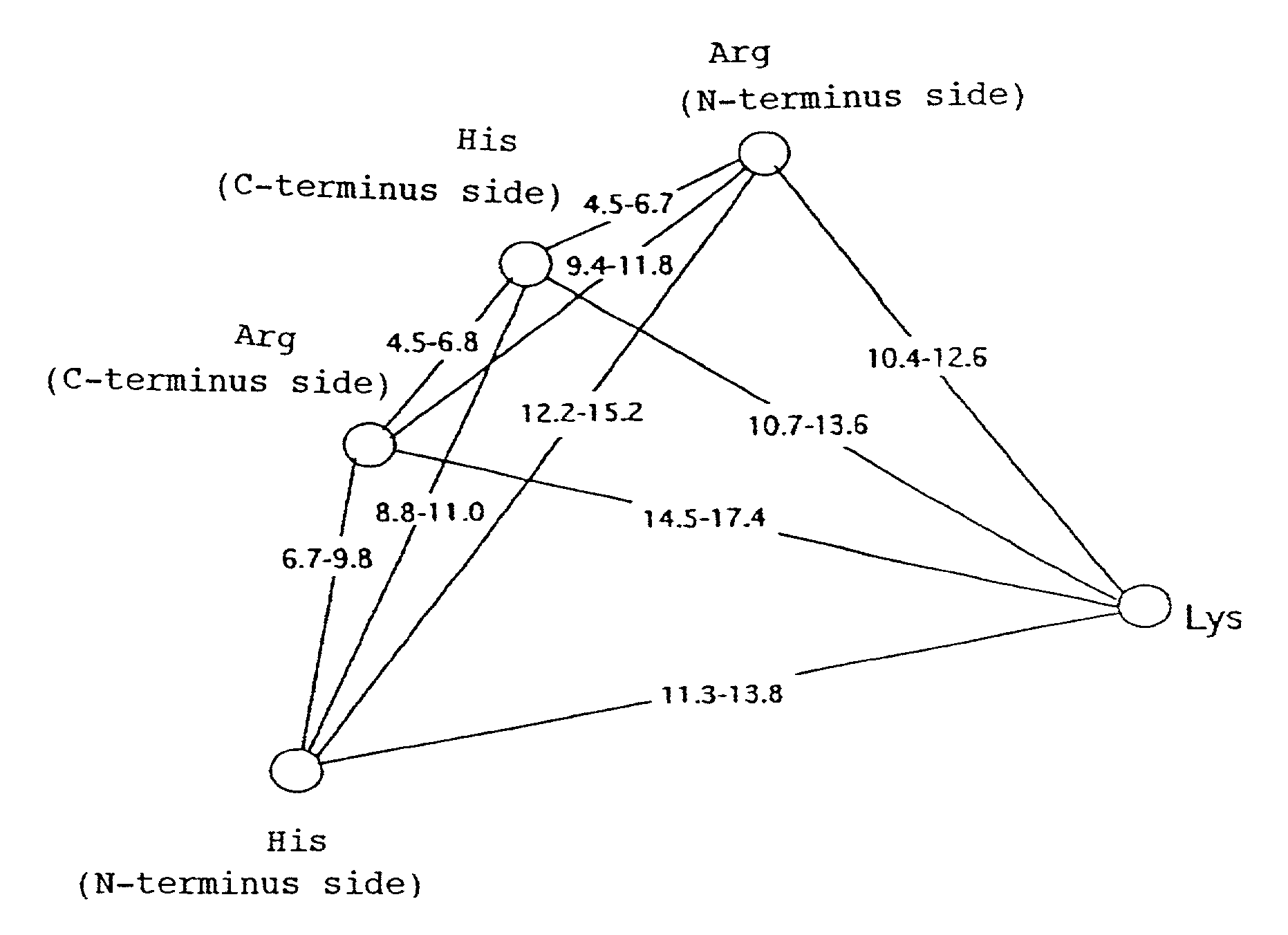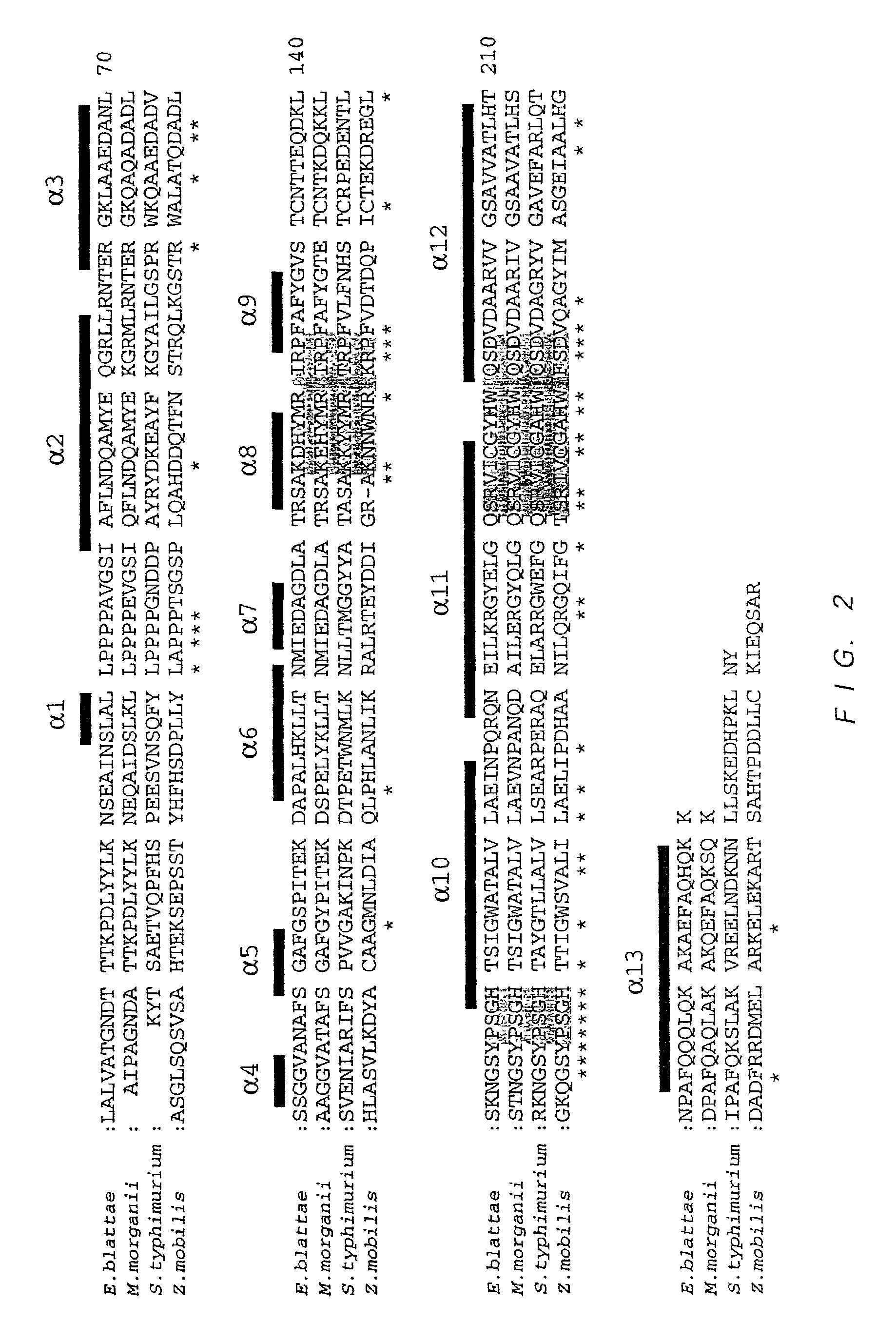Variant nucleoside-5′-phosphate producing enzyme
a technology of nucleosides and phosphates, applied in the direction of enzymology, peptide/protein ingredients, transferases, etc., can solve the problems of decomposition of accumulated nucleoside-5′-phosphates, and achieve the effect of improving the productivity of nucleoside-5′-phosphates
- Summary
- Abstract
- Description
- Claims
- Application Information
AI Technical Summary
Benefits of technology
Problems solved by technology
Method used
Image
Examples
example 1
Crystallization of Wild-Type EB-AP
[0131]Crystallization was performed by using vapor diffusion in the hanging drop method. A 20 mM sodium phosphate buffer (pH 8.0) containing the wild-type EB-AP (concentration: 10 mg / ml) and a 100 mM Tris-HCl buffer containing 45% (w / v) of polyethylene glycol 400 in the same amounts (7–10 μl each) were dropped and mixed on siliconized cover glass, and a well filled with 500 μl of 100 mM Tris-HCl buffer containing 45% (w / v) of polyethylene glycol 400 was covered with the cover glass so that a drop of the mixed solution should be hung above the well and left stand at 20° C. Crystals appeared within a few days, and they grew up to hexagonal columnar crystals in a measurable size (about 0.3×0.3×1.2 mm) within 1 to 2 weeks. For the X-ray data measurement, the crystals were transferred into 100 mM Tris-HCl buffer (pH 8.0) containing 50% (w / v) polyethylene glycol 400.
[0132]Upon handling of these crystals, it was necessary to pay attention to the following ...
example 2
Crystallization of G74D / I153T Mutant EB-AP
[0134]Crystallization was performed by using vapor diffusion in the hanging drop method. A 20 mM sodium phosphate buffer (pH 8.0) containing the G74D / I153T mutant EB-AP (concentration: 20 mg / ml) and a 20 mM Tris-HCl buffer containing 38% (w / v) of polyethylene glycol 400 in the same amounts (5 μl each) were dropped and mixed on siliconized cover glass, and a well filled with 500 μl of 20 mM Tris-HCl buffer containing 38% (w / v) of polyethylene glycol 400 was covered with the cover glass so that a drop of the mixed solution should be hung above the well and left stand at 20° C. Crystals appeared within a few days, and they grew up to tabular crystals in a measurable size (about 0.7×0.4×0.2 mm) within 1 week. For the X-ray data measurement, the crystals were transferred into 100 mM Tris-HCl buffer (pH 8.0) containing 50% (w / v) polyethylene glycol 400.
[0135]Using an X-ray diffraction apparatus, R-AXIS IIc of Rigaku Co., Ltd., X-ray diffraction da...
example 3
Crystallization of Complex of Wild-Type EB-AP and Molybdate (Reaction Intermediate Analogue)
[0136]Crystallization was performed by a co-crystallization method by using vapor diffusion in the sitting drop method. A 20 mM sodium phosphate buffer (pH 8.0) containing the wild-type EB-AP (concentration: 10 mg / ml) and a 100 mM Tris-HCl buffer containing 40% (w / v) of polyethylene glycol 400 and 1 mM sodium molybdate in the same amounts (15 μl each) were added dropwise to a hollow of a bridge provided on a well filled with 500 μl of 100 mM Tris-HCl buffer containing 40% (w / v) of polyethylene glycol 400, mixed, and left stand at 20° C. Crystals appeared within a few days, and they grew up to rhomboidal crystals in a measurable size (about 0.3×0.3×0.3 mm) within 1 to 2 weeks. For the X-ray data measurement, the crystals were transferred into 100 mM Tris-HCl buffer (pH 8.0) containing 50% (w / v) polyethylene glycol 400.
[0137]Using an X-ray diffraction apparatus, R-AXIS IIc of Rigaku Co., Ltd., ...
PUM
| Property | Measurement | Unit |
|---|---|---|
| Molar density | aaaaa | aaaaa |
| Molar density | aaaaa | aaaaa |
| Molar density | aaaaa | aaaaa |
Abstract
Description
Claims
Application Information
 Login to View More
Login to View More - R&D
- Intellectual Property
- Life Sciences
- Materials
- Tech Scout
- Unparalleled Data Quality
- Higher Quality Content
- 60% Fewer Hallucinations
Browse by: Latest US Patents, China's latest patents, Technical Efficacy Thesaurus, Application Domain, Technology Topic, Popular Technical Reports.
© 2025 PatSnap. All rights reserved.Legal|Privacy policy|Modern Slavery Act Transparency Statement|Sitemap|About US| Contact US: help@patsnap.com



